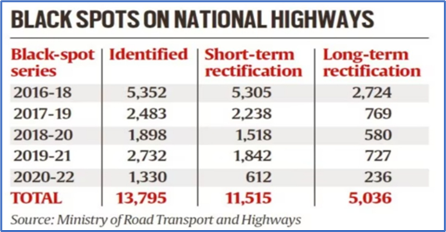Why in news?
To curb road accidents and fatalities, the Ministry of Road Transport and Highways (MoRTH) will soon release black spot data for 2023 and 2024 using the Electronic Detailed Accident Report (e-DAR)/Integrated Road Accident Database (iRAD) system, which compiles real-time accident data from state police.
What’s in Today’s Article?
- Black Spots on National Highways
- Electronic Detailed Accident Report (e-DAR) System
- MoRTH to Release Real-Time Highway Black Spot Data Using e-DAR
Black Spots on National Highways
- India continues to record one of the world’s highest road accident rates, with a large share of fatalities occurring on national highways (NHs) due to accident-prone “black spots” — poorly designed or managed road segments.
- In March 2025, the Parliamentary Standing Committee on Transport, Tourism and Culture, criticised the MoRTH for what it called a “significant governance failure.”
- Out of 13,795 black spots identified across NHs, only 5,036 have been permanently rectified, leaving thousands of dangerous zones unaddressed.
- Three-Tier Action Plan
- The panel proposed a time-bound, three-tier plan to fix black spots:
- Category A (High Risk): Immediate safety steps; permanent fix within 30 days.
- Category B (Moderate Risk): Fix within 90 days.
- Category C (Low Risk): Fix within 180 days.
- Agencies missing deadlines should face penalties.
- Accountability and Targets
- The committee urged post-implementation audits at 3-month and 12-month intervals and a public dashboard to track progress.
- Although MoRTH aims to reduce road fatalities by 95% by 2028 and eliminate all black spots by FY 2027-28, progress remains slow — with short-term fixes outpacing long-term structural solutions.
Electronic Detailed Accident Report (e-DAR) System
- The Integrated Road Accident Database (iRAD) and e-Detailed Accident Report (e-DAR) system, developed by the Ministry of Road Transport and Highways (MoRTH), serves as India’s national database for road accidents.
- It enables real-time data collection by police using a mobile app and supports data-driven policymaking to improve road safety and speed up victim compensation.
- Key Objectives
- Build a centralized national database of road accidents.
- Analyze crash data to identify causes and risk patterns.
- Enable targeted road safety measures and infrastructure interventions.
- Streamline and accelerate compensation claims for accident victims and their families.
- How the System Works?
- Data Collection: Police officers record accident details instantly using the iRAD app, capturing photos, videos, time, date, and location.
- Unique ID Creation: Each case gets a unique accident ID for easy tracking.
- Information Dissemination: Data is uploaded to a central database, and engineers from relevant departments are alerted for analysis and action.
- Analysis and Reporting: The system generates reports and dashboards to identify black spots and analyze accident causes.
- Claims Processing: Through the e-DAR portal, victims’ families can access accident data to file compensation claims faster.
MoRTH to Release Real-Time Highway Black Spot Data Using e-DAR
- To reduce road accidents and fatalities, the MoRTH will soon publish black spot data for 2023 and 2024 using its Electronic Detailed Accident Report (e-DAR) and Integrated Road Accident Database (iRAD) system.
- This platform collects real-time, geo-tagged accident data entered by state police through mobile apps, enabling quicker identification of high-risk stretches.
- A black spot on a National Highway (NH) is defined as a 500-metre stretch that records either five or more fatal or grievous accidents or ten deaths within three years.
- These areas are prioritised for safety improvements under the government’s road safety programme.
- Data Coverage and Progress So Far
- So far, data up to 2022 was available, limiting preventive planning.
- Using e-DAR/iRAD, MoRTH has now compiled data for 2023–2024, to be released soon.
- From 2016–2022, 13,795 black spots were identified on NHs, and long-term rectification has been completed on 5,036 stretches.

- Bridging Data Discrepancies
- The Transport Research Wing (TRW) validates black spot data collected from states.
- Discrepancies between TRW and e-DAR data have now dropped to below 5%, after extensive coordination with states — though Punjab and Jharkhand earlier showed the highest mismatches.
- In 2024, MoRTH recorded a difference of 18,069 accidents (3.96%) and 7,020 fatalities (4.3%) between the two systems.
- MoRTH officials said efforts are underway to align e-DAR data with state police records, ensuring accuracy and better planning.
- Once streamlined, the system will enable faster identification and rectification of accident-prone zones, marking a major step toward data-driven road safety management in India.










